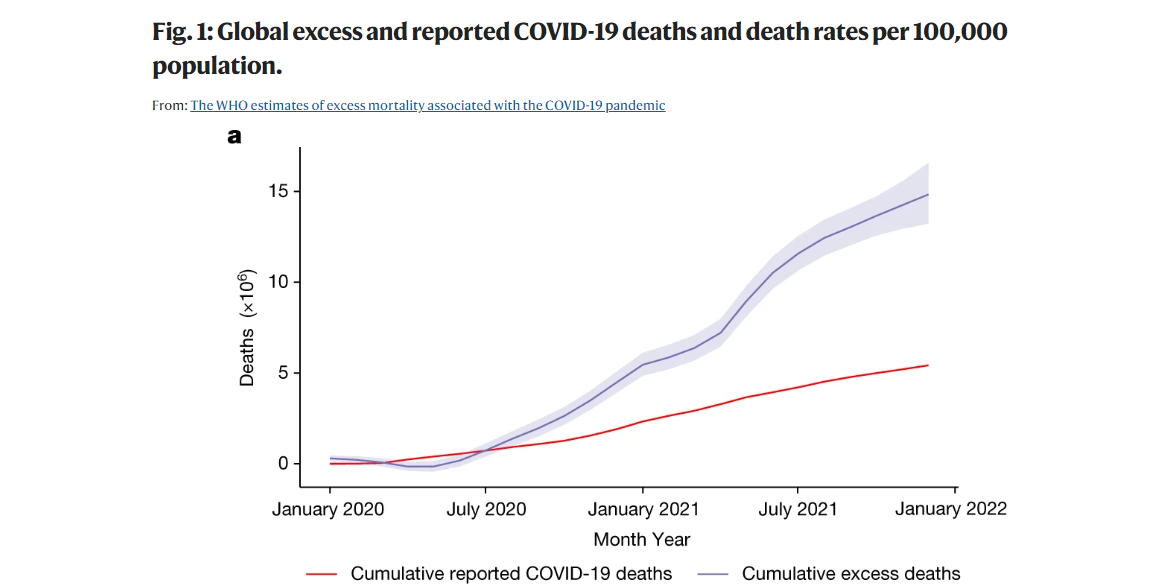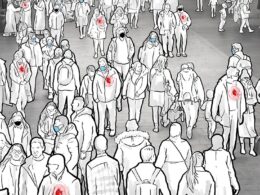the health institute
for continuous health transformation
Joaquim Cardoso
Founder and Chief Researcher, Editor and Advisor
December 14, 2022
This is a republication of the paper “The WHO estimates of excess mortality associated with the COVID-19 pandemic”, with the title above. The Post is preceded by an Executive Summary.
Executive Summary [William Msemburi]
Our paper on the excess mortality associated with the COVID-19 pandemic is now live. There are 4 key messages:
Firstly, COVID-19 has resulted in dramatic global excess mortality — 14.83 million deaths over 2020–2021.
- The majority of the countries in the world have seen substantive increases in mortality.
Secondly, both the reported COVID-19 mortality and estimated excess have been higher in 2021 than in 2020.
Thirdly, excess mortality is much higher than reported COVID-19 mortality globally.
- In many countries COVID-19 deaths have been reported accurately, yet in others, the estimated excess mortality is much higher than reported COVID-19 mortality, occasionally by several orders of magnitude.
- In total, the estimates show that global excess mortality is 2.74 times higher than reported COVID-19 deaths which points to the potential undercount in the reported statistics.
Finally, for almost half the countries of the world, tracking excess mortality is not possible using the data that are available and for these we must rely on statistical models.
- Critically, the missing countries are not randomly spread across the globe but are generally from the low- and middle-income economies.
- It is crucial that we highlight these data gaps and call for greater investment in civil registration and vital statistics systems.
- Gaps in information lead to gaps in response perpetuating unequal access to interventions that could improve the lives of all populations.
Note about higher excess deaths (by the editor of the site)
- There are an estimated 4.74 million excess deaths for India alone in the period January 2020 to December 2021,
- followed by 1.07 million excess deaths in the Russian Federation,
- 1.03 million excess deaths in Indonesia and
- 932K excess deaths in the United States of America.
How does it compare to other diseases?
- The greater proportion of global excess is derived using observed mortality data and the estimated toll is staggeringly high.
- To place these estimates in context, the leading cause of death in 2019 was ischaemic heart disease, with 8.9 million deaths
Infographic
Fig. 1: Global excess and reported COVID-19 deaths and death rates per 100,000 population.
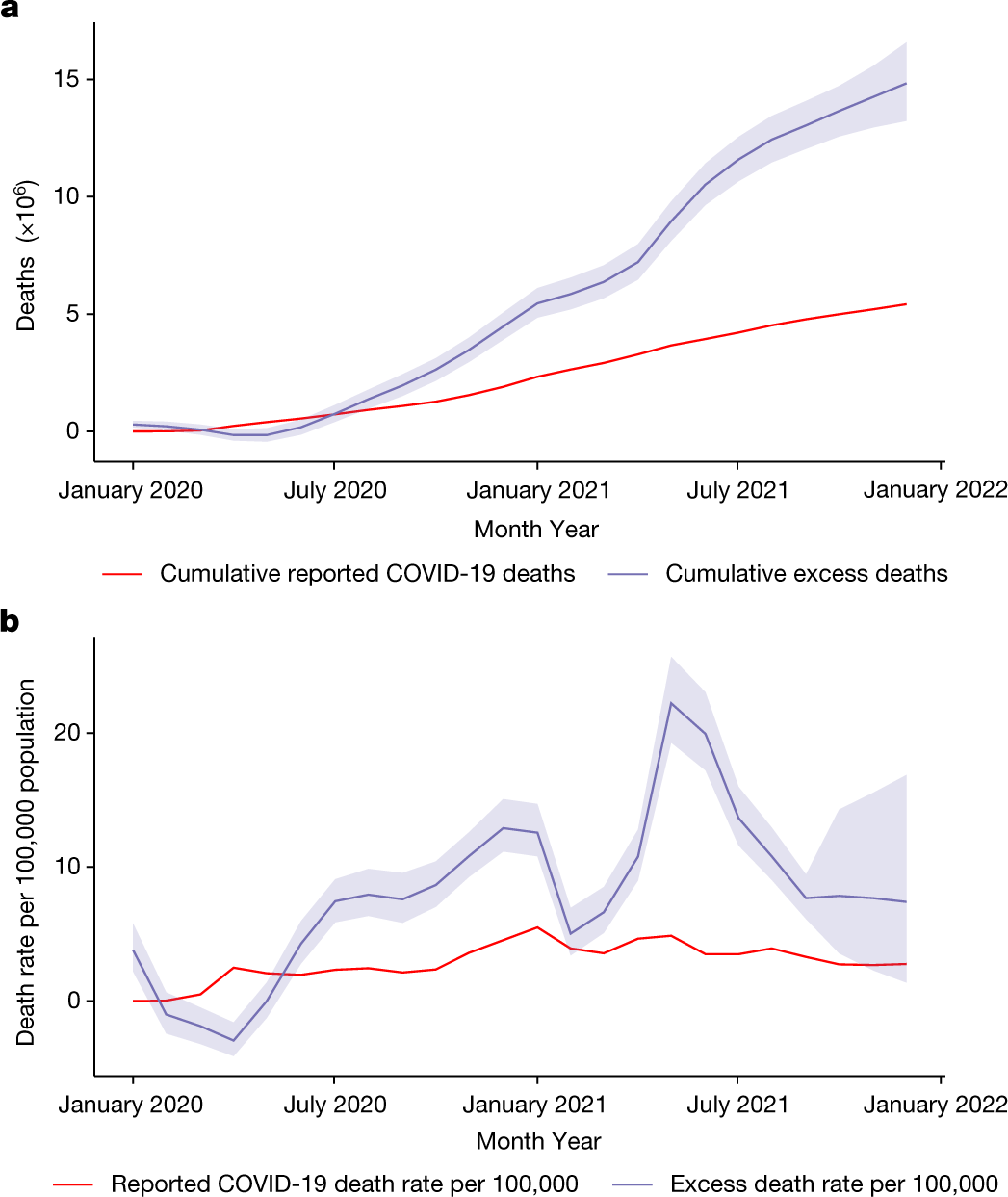
Fig. 2: Global and WHO region P-scores (excess deaths relative to expected deaths).

Fig. 3: The 25 countries with the highest total estimated excess deaths between January 2020 and December 2021.
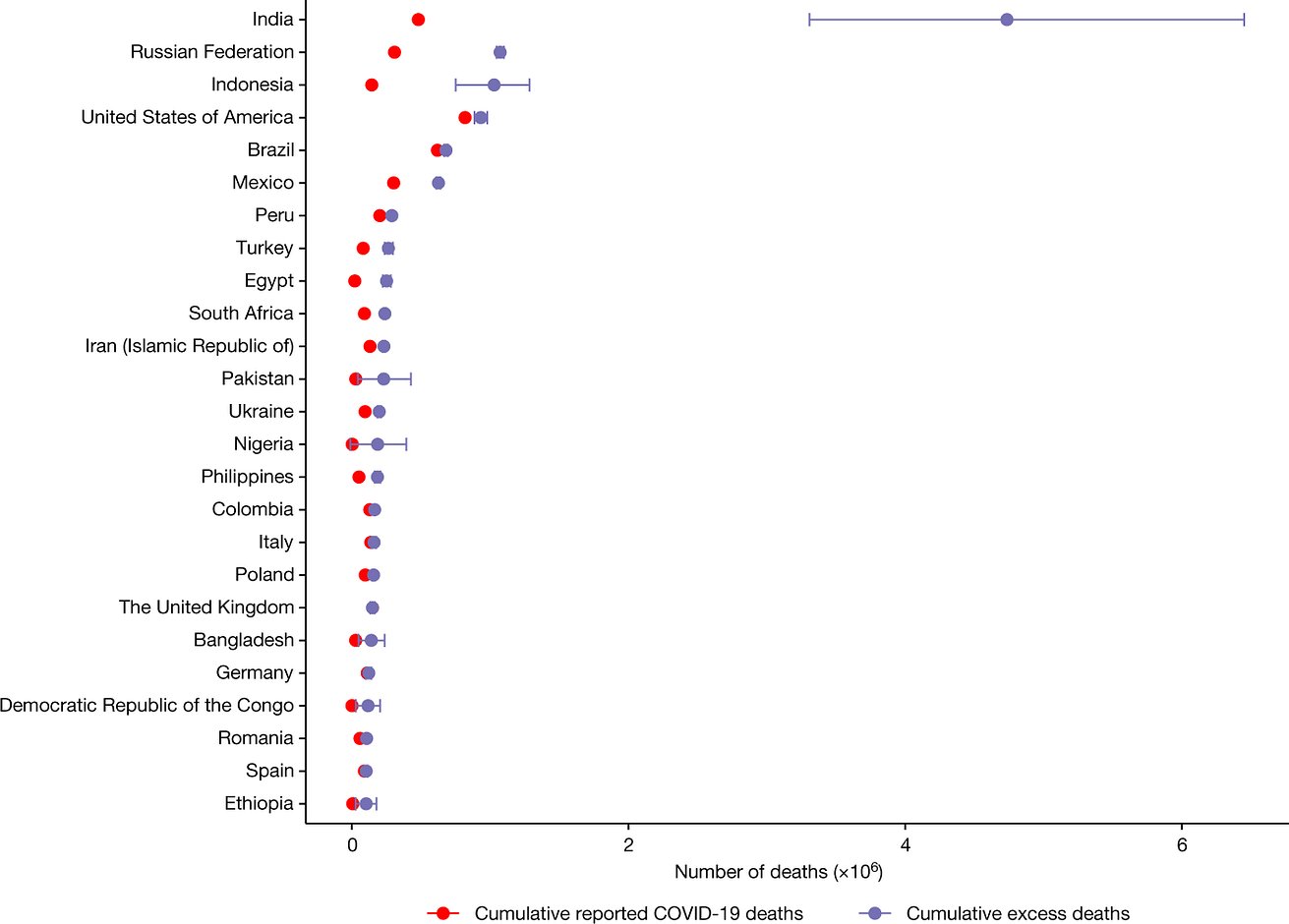
What are the lessons learned and recommendations (from a surveillance system perspective]
In the two years within which the COVID-19 pandemic has severely impacted humanity, important lessons remain to be fully documented and harnessed as part of the global public health surveillance capacity.
- First, the urgent need to improve data and health information systems and the way data are collected, analysed, shared and reported.
- Second, the required alignments of communicable disease surveillance with the continuous strengthening of health information systems and their integration with other existing routine surveillance systems, and with demographic and geographic monitoring systems to facilitate timely and targeted interventions.
- COVID-19 surveillance must also be combined with Universal Health Coverage and the International Health Regulations monitoring and related indicators for health-system preparedness, including vaccine coverage and water, sanitation and hygiene services.
To emerge from this crisis, the world needs to be able to monitor mortality and morbidity with real-time, reliable and actionable data.
- Strengthened country capacity for data and information requires collaboration across governmental and non-governmental institutions, including ministries of health and finance, hospitals, insurance companies, charities, national statistics institutions, offices of the registrar general, local and regional government, think tanks, academia and more.
- Monitoring systems of specific causes and ACM at the national, regional and global levels may serve as an early warning system for future health emergencies that will allow more timely responses to prevent local outbreaks from inflicting harms on lives and livelihoods in their immediate surroundings and across the world.
- Gaps in knowledge and data lead to gaps in response.
- It is thus vital for future responses that countries have well-functioning CRVS systems, which are the foundation upon which monitoring, prevention and future advancements on health rest.
ORIGINAL PUBLICATION (excerpt)
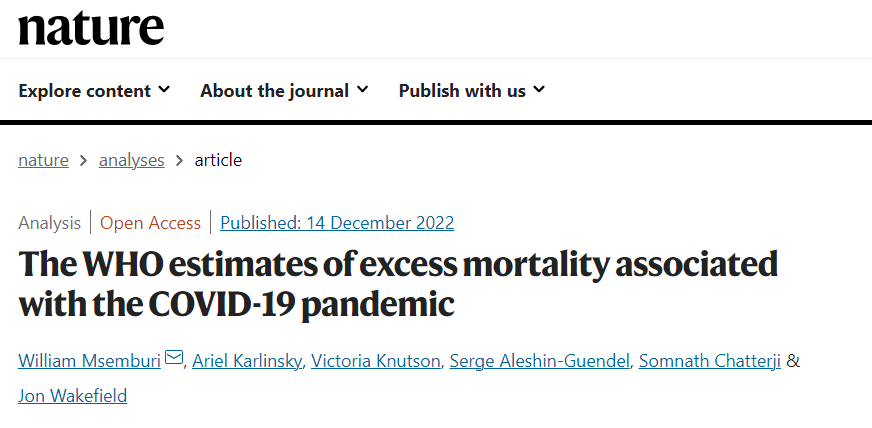
The WHO estimates of excess mortality associated with the COVID-19 pandemic
Nature
William Msemburi, Ariel Karlinsky, Victoria Knutson, Serge Aleshin-Guendel, Somnath Chatterji & Jon Wakefield
Main
The COVID-19 pandemic caught the world unprepared, and it has exacted a toll many would have considered inconceivable in the modern era before its emergence.
As of 31 December 2021, more than 287 million confirmed cases of COVID-19 across the world had been reported to the World Health Organization (WHO) including 5.4 million deaths ( https://covid19.who.int/).
From the documenting of initial COVID-19 cases in Wuhan, China in December of 2019 through to the WHO declaring it a pandemic in March of 20201, accurately tracking COVID-19 and its impact has been riddled with challenges. An initial major challenge was developing the diagnostic tools to correctly identify the presence of the virus.
A number of countries relied on pre-existing platforms to achieve this and they quickly adapted and scaled up the available technologies to allow for COVID-19 testing.
However, many countries lacked such capacity.
In addition, countries have differed in their application of standards for the certification of COVID-19 as the underlying cause-of-death2.
This has caused both country-level and worldwide assessment of the spread and impact of the pandemic to be incomplete.
An estimate of the excess mortality associated with the COVID-19 pandemic is therefore a better measure of the overall impact of the crisis.
Excess mortality is defined as, “The difference in the total number of deaths in a crisis compared to those expected under normal conditions”3.
Excess mortality accounts for both the total number of deaths directly attributed to the virus and those resulting from the indirect impact, such as disruption to essential health services or travel disruptions4.
Excess mortality is a well established concept dating back centuries5, and has been used extensively to estimate the toll of past health crises and pandemics such as the 1918 ‘Spanish Flu’6.
The measure overcomes the variation among countries in reporting and testing and the misclassification of the cause of death on death certificates7and requires only information on the total number of deaths during the health crisis, and before, to establish the expected number of deaths.
Unfortunately, excess mortality cannot be directly estimated for all countries owing to many not having the requisite all-cause mortality (ACM) data.
The WHO usually receives routine mortality data on an annual basis following the year of death or after an even longer lag.
Civil registration and vital statistics (CRVS) systems differ across countries with varying completeness, timeliness and quality control measures for compiling unit record cause of death numbers into aggregates identified by cause, age, sex, place and period of death8,9,10,11.
Moreover, differential reporting coverage, the absence of electronic surveillance systems in some locations and limited investments in CRVS systems has resulted in many nations lacking the structures necessary to provide good-quality routine data, even before the onset of the pandemic.
Correspondingly, they lack the capacity and data required to monitor ACM during this unprecedented pandemic.
This results in numerous countries being unable to contribute to the centralized systematic mortality surveillance that would be necessary for the WHO to measure global-, regional- and country-level excess mortality.
Acknowledging these data gaps, a model-based framework, relying on ACM information from countries for which data exist and other relevant factors, has been developed by the WHO.
The purpose of this framework is to estimate country, regional and global excess deaths from 1 January 2020 to 31 December 2021 on a monthly timescale.

Process, methods and data & Additional Sections
See the original publication (this is an excerpt version only)
Global, regional and income group summary
Globally, for the period January 2020 to December 2021, we estimate 14.83 million excess deaths with an uncertainty interval (UI) of 13.23 million to 16.58 million, which is 2.74 (UI 2.44 to 3.06) times higher than the 5.42 million COVID-19 deaths reported to the WHO for this period.
Globally, for the period January 2020 to December 2021, we estimate 14.83 million excess deaths with an uncertainty interval (UI) of 13.23 million to 16.58 million, which is 2.74 (UI 2.44 to 3.06) times higher than the 5.42 million COVID-19 deaths reported to the WHO for this period.
Throughout the paper, the reported UIs are 95% Bayesian credible intervals. We estimate 4.47 (UI 3.91 to 5.07) excess deaths in 2020 and 10.36 (UI 9.06 to 11.97) in 2021 globally.
Turning to the P-scores, there were 7.97% (UI 6.96% to 9.03%) and 18.30% (UI 15.99% to 21.15%) increases in deaths globally in 2020 and 2021, respectively, compared to what we would have expected if the pandemic had not occurred.
The top panel of Fig. 1 shows the cumulative excess and reported COVID-19 deaths by month.
We see the steepening of the curve in the middle of 2021.
This sharp increase is almost entirely due to the estimate of the catastrophic wave that hit India at this time.
In the bottom panel, the monthly excess death rate per 100,000 is plotted, and again, the peak towards the middle of 2021 is evident.

a, Cumulative global excess death estimates and the cumulative reported COVID-19 deaths by month from January 2020 to December 2021. b, Global excess death rates per 100,000 population and the reported COVID-19 death rates per 100,000 population, also by month, from January 2020 to December 2021. On both plots, the central lines of the excess mortality series show the mean estimates and the shaded regions indicate the 95% uncertainty intervals.
In the Extended Data Table 1 we provide summaries aggregated across all 194 WHO member states to give global estimates for the period January 2020 to December 2021.
We also aggregate the member state estimates according to the six WHO regions and for the same period. The greatest contribution to the total is estimated for the SEAR region. The ratio of excess mortality to reported COVID-19 mortality is greatest in the AFR and SEAR regions, although we must emphasize that these are the regions with the greatest data paucity. As measured by the P-score, the worst affected regions were AMR (22%) and SEAR (22%), with EUR (17%) and EMR (12%) having intermediate values and AFR (8%) and WPR (0%) having the lowest values.
In the Extended Data Table 2 we also provide the corresponding summaries when the member state estimates are aggregated according to the four World Bank income groupings.
There are wide variations across the respective economies but in general the estimates point to excess mortality being magnitudes higher than the reported COVID-19 mortality. Over 50% of the estimated excess occurs in lower-middle income economies. The low-income economies include much of sub-Saharan Africa, which reported relatively few COVID-19 deaths.
In Fig. 2 we plot P-scores by month globally and for each WHO region.
The global P-score increases steadily to the end of 2020, and then drops before a sharp increase in the middle of 2021, followed by a steady decline. The striking peak is in SEAR for the middle of 2021 for which we estimate that more than twice as many deaths have occurred, relative to those expected for this period. AMR has a peak in January 2021, and EUR has a peak at the end of 2020, and then drops before steadily increasing in 2021.

Selected country summary
Figure 3 displays the excess deaths estimates and reported COVID-19 death counts for the 25 countries with the highest numbers of estimated excess deaths, along with error bars for the uncertainty interval.
The 20 countries with the highest excess estimates represent approximately half (48.9%) the global population and account for over 80% of the estimated global excess deaths for the January 2020 to December 2021 period.
These countries are (in alphabetical order) Bangladesh, Brazil, Colombia, Egypt, India, Indonesia, Iran, Italy, Mexico, Nigeria, Pakistan, Peru, the Philippines, Poland, the Russian Federation, South Africa, the United Kingdom, Turkey, Ukraine and the United States of America.
- There are an estimated 4.74 million (UI 3.31 to 6.45 million) excess deaths for India alone in the period January 2020 to December 2021,
- followed by 1.07 million (UI 1.05 to 1.10 million) excess deaths in the Russian Federation,
- 1.03 million (UI 0.75 to 1.29 million) excess deaths in Indonesia and
- 932K (UI 887K to 978K) excess deaths in the United States of America.
Figure 3 contains countries of all possible data types in our model:
- Countries with full ACM data for the entire analysed period (Russian Federation, United States of America, Brazil, Egypt, Spain and so on) for which the uncertainty in the estimates comes from the expected (counterfactual) number of deaths and is therefore relatively narrow.
- Countries with mixed ACM data (India, Indonesia, Turkey), that is, subnational data projected to the national level. This produces an additional layer of uncertainty from the projection of the information to the national level.
- Countries for which ACM data were unavailable (Pakistan, Nigeria, Ethiopia and so on), where the estimates are derived from the covariate prediction model. In these countries the uncertainty is the highest and results are to be interpreted with the greatest caution. However, the estimated undercount in these countries is well within the plausible range of undercounts as estimated for countries with full ACM data.
The total estimated excess deaths are heavily determined by the population size of each country.
Figure 4 shows a map of the estimated P-scores for 2020–2021, and Fig. 5 displays the 25 countries with the highest estimated P-scores. In both figures the P-scores are calculated using expected numbers over 2020–2021.
From the P-score point of view, the worst impacted countries generally have smaller populations than those from Fig. 3.
For example, India and the United States of America have the highest and fourth highest estimated excess deaths in the world in absolute terms but the United States of America is absent from the top 25 and India is 21st in the list.
On the other hand, smaller countries such as Peru, Bulgaria and Bolivia have been impacted more heavily, relative to population size, when examining excess mortality in absolute terms.
So far as individual countries are concerned, Peru has a devastating P-score estimate of 97%, a doubling of deaths over the pandemic relative to what was expected.
Other countries with a large increase include Ecuador with a 51% increase in deaths and Bolivia with a 49% increase.
Figure 6 maps the ratio of excess deaths to reported COVID-19 deaths. There is a wide range for this excess measure, with many countries in the AFRO region having high ratios, and countries in Western Europe having ratios closer to 1 (with some, such as France, having values below 1). Globally, over January 2020-December 2021, there were 5,420,534 reported COVID-19 deaths, and according to our estimates, the ratio of excess to reported COVID-19 deaths is 2.74 (UI 2.44 to 3.06), which is a huge discrepancy.
As mentioned previously, we estimate the highest cumulative excess death numbers for India, accounting for 4.74 million deaths with a 95% credible interval of (3.31, 6.45) million.
We base this estimate for India on subnational data-we have mortality data for 17 states and union territories (out of 36) over the pandemic.
Using a proportionality assumption as discussed in the Methods and in Knutson et al.15, we produce a national estimate.
In the Supplementary information we summarize excess estimates from other studies that use different data sources and illustrate that our estimates are consistent with these estimates.
A crucial component of the excess calculation is the estimation of the expected number of deaths.
There are two elements to the calculation, the mortality data upon which it is based and the model that is adopted.
First, with respect to the data, the WHO adjust the raw mortality counts, if there is perceived to be any incompleteness in reporting (and the scaling value may be carried forward to the pandemic period). We note that as part of the process to produce excess estimates, country consultation is carried out, in which the adjusted country numbers are shared with nationally nominated focal points who are tasked with reviewing the adjusted counts.
Second, for the expected counts modelling, we used splines both for the annual trend and for the within-year seasonal variation. A country for which the completeness adjustment and spline modelling provided a less than satisfactory excess estimate was Germany. Under the default data process/spline modelling the excess estimate was 195,000 with 95% credible interval (161,000, 229,000). However, on closer examination this excess estimate was too high because of a combination of data/model issues. For Germany, ACM in 2016–2018 were scaled up owing to the completeness assessment, which lead to a dip in the ACM sequence in 2019. The annual spline fit to these adjusted data produced expected numbers that were too low (and therefore an excess that was too high). Hence, we reanalysed the Germany data with unadjusted data and a linear term, rather than a spline. This produced a more realistic excess estimate of 122,000 with a 95% credible interval of (101,000, 143,000).
For Sweden, we were concerned there were similar issues because of an unnecessary completeness adjustment of the raw mortality figure reported to the WHO in 2019 (the mortality count was lower than recent counts). The original excess estimate was 11,300 (9,900, 12,700). On closer scrutiny, we decided that this adjustment was not necessary and we redid the analysis for Sweden, again including a linear term for the annual trend instead of a spline (for the same reasons as described for Germany). This operation resulted in an estimate for Sweden that was higher, specifically 13,400 (11,700, 15,200). The changes in the excess estimates for Germany and Sweden do not change the global or EURO figures substantively (and the figures quoted in this paper are based on the revised estimates). As a side note, for both these countries when using the unadjusted data, both the linear and spline annual trend models produced similar excess estimates. However, using a spline for the annual trend can lead to sensitivity to the last year of pre-pandemic data, and a priority going forward is to systematically compare and evaluate different models for producing the expected numbers, building on recent work16. For the next round of estimates we will also revisit the under-reporting adjustment procedure. More details on revisiting the Germany and Sweden estimates are in the Supplementary information.
A natural inclination is to rank countries in terms of one of the metrics we have discussed. Basing rankings on point estimates will often be misleading because, particularly in the context of estimating excess mortality, there will often be considerable uncertainty in the chosen metric for a given country.
In the Methods, we include an illustrative example of a rankings analysis, using the excess rate. We show how one can evaluate the (posterior) probability that the excess is greater in one country than in another and provide graphical summaries to aid in interpretation. We also discuss the temporal comparison of rankings. In the Supplementary information, we describe a more substantive analysis that addresses how the United Kingdom compared to countries of the European Union, in terms of the excess rate and the P-score, over the pandemic.
In general, one can rarely simply look at the excess rate and associated rankings and make statements concerning the manner in which a country dealt with the pandemic, as there are many factors at play.
These include: the age structure of the population, the population density and cultural practices, the government responses during different periods of the epidemic, how the population responded to government actions, and the infectiousness and fatality rates of the various variants that were present at different times.

Discussion
These estimates call our attention to four important points.
First and foremost, COVID-19 has resulted in marked global excess mortality:
- 14.83 million deaths (13.23, 16.58) over 2020–2021.
- In 2020, the excess was 4.47 (3.91, 5.07) million and in 2021, the excess was 10.36 (9.06, 11.97) million.
- The majority of the countries in the world have seen substantive increases in mortality.
Second, both the reported and excess estimated toll of COVID-19 were heavier in 2021 than in 2020.
Third, excess mortality is much higher than reported COVID-19 mortality globally.
In many countries COVID-19 deaths have been reported accurately, yet in others, the estimated excess mortality is much higher than reported COVID-19 mortality, occasionally by several orders of magnitude.
In total, the estimates show that global excess mortality is 2.74 times higher than reported COVID-19 deaths.
Finally, for almost half the countries of the world, tracking excess mortality is not possible using the data that are available and for these we must rely on statistical models.
Critically, the missing countries are not randomly spread across the globe and so the countries with missing data may be systematically different from the sample of countries for which we do have data when we account for the age distributions of the populations, the underlying disease burdens of the countries, what is known about the strengths of their health systems and potentially most importantly, when, and how the pandemic evolved within their borders.
These differences considered, some of the estimates and uncertainty intervals for locations for which we know very little must be interpreted with caution.
Despite its strengths, this study has important limitations extending beyond the data paucity mentioned above.
The non-COVID counterfactual trend is derived using historical data and is sensitive to the assumptions made in the forecast.
The weight given to recent data years relative to those further back in time, and how smoothly changes over time are projected to persist into the pandemic period, can influence the expected levels.
We used spline models as the basis for the modelling of the expected numbers, but as we have mentioned will revisit this choice for the next round of estimates, as such models can produce inappropriate extrapolations.
Another limitation relates to the quality of the input data used. The completeness of observed deaths and the consistency in quality as well as construct validity for the various covariates used in the regression model, impact the accuracy of the empirical estimates of excess and the robustness of the predictive model for deriving excess for countries in which deaths have not been observed16.
Currently, completeness of reporting during the pandemic is based on historic completeness of registered deaths relative to the WHO Global Health Estimates (GHE)17.
The GHE uses multiple data sources to generate country-, age-, sex-, year- and cause-specific mortality estimates, which in turn undergo extensive country consultation.
However, comparing 2019 estimates of the GHE to registered deaths from even high-quality registration systems, some differences are observed.
Subsequent iterations of the excess mortality work will include updates to how the expected deaths are derived and how completeness of reporting is calculated and extrapolated to the pandemic period.
The greater proportion of global excess is derived using observed mortality data and the estimated toll is staggeringly high.
To place these estimates in context, the leading cause of death in 2019 was ischaemic heart disease, with 8.9 million deaths ( https://www.who.int/news-room/fact-sheets/detail/the-top-10-causes-of-death).
Information on the leading causes of death is not currently available for the pandemic years, but we would expect COVID-19 to be among the leading causes of death in 2020 and the leading cause of death in 2021.
We estimate that the mean global per capita excess mortality rate was 0.06% in 2020, more than doubling to 0.13% in 2021.
This surpasses the influenza pandemics of 1957, 1968 and 2009 (estimated at 0.04%, 0.03% and 0.005%, respectively)18.
However, the 1918 influenza pandemic was magnitudes higher, with an estimated 1.0% per capita excess mortality rate, or 75 million global excess deaths when adjusted to the 2020 population18.
However, the 1918 influenza pandemic was magnitudes higher, with an estimated 1.0% per capita excess mortality rate, or 75 million global excess deaths when adjusted to the 2020 population18.
Excess mortality quantifies the increase in mortality from all causes, including direct COVID-19 deaths, indirect COVID-19 deaths (for example, health-system overload) and strictly non-COVID-19 deaths (for example, those resulting from other health shocks such as violent conflict or disasters).
These estimates from the WHO cannot quantify the relative importance of each of these factors.
However, considering the low levels of excess mortality in countries in which COVID-19 transmission, infection and mortality rates were low during some of the analysed period (for example, Malaysia, Mongolia, Uruguay in 2020) or its entirety (for example, Australia, Japan, New Zealand), suggests that in many countries the greater proportion of excess deaths can be attributed to COVID-19 directly.
In fact, where accurately quantified, excess mortality may provide a reliable lower-bound on COVID-19 deaths considering that for several countries, we have mortality deficits or negative estimates for certain months.
The greater number of these countries have high-quality reporting systems and this deficit is due to deaths from non-natural and natural causes decreasing during the analysed period13and there having been less severe influenza seasons in 2020 and 2021 relative to previous years19.
In many such countries, mortality improvements may be attributable to health systems being especially geared up to respond, the populations seeking early attention because of heightened sensitivity to health issues, compliance with public health and social measures that could reduce transmission of other infections and containment measures such as lockdowns.
However, we are also aware that there have been non-COVID-19-related crises that have been experienced by some countries, for example, the conflict in Armenia, for which only a proportion of the excess mortality in 2020 would rightly be associated with COVID-19.
The alternative to excess mortality estimates-that is, relying on reported COVID-19 deaths-represents a severe undercount of the toll.
Indeed, even in countries with ACM data for which the estimates are much more certain, mortality has risen substantially such that excess mortality is much higher than reported COVID-19 deaths, whether it is by 50% or by several hundred per cent.
There is very little chance that the countries for which ACM data are not available have been able to report COVID-19 deaths accurately.
There is ample, albeit preliminary evidence from many countries for which ACM data were not obtained (such as Pakistan and Haiti), that mortality has increased, and excess mortality is much higher than reported COVID-19 deaths.
As another example, in the Africa region for which ACM data are most lacking, recent studies have highlighted the underestimation in the reported statistics20.
In this region, the direct estimates of the ratio between excess mortality and reported COVID-19 deaths spans the gamut from about 1 in Tunisia to 2.62 in South Africa, 12 in Egypt and over 20 in Algeria.
Thus, although a total regional estimate of a ratio of 8.03 might seem high at first glance, it is well within bounds of the more certain ratios and the true, yet unknown ratio, may very well be even higher both regionally and globally.
As already noted, the excess estimates for sub-Saharan Africa are the least robust because of a paucity of data.
In the two years within which the COVID-19 pandemic has severely impacted humanity, important lessons remain to be fully documented and harnessed as part of the global public health surveillance capacity.
First, the urgent need to improve data and health information systems and the way data are collected, analysed, shared and reported.
Second, the required alignments of communicable disease surveillance with the continuous strengthening of health information systems and their integration with other existing routine surveillance systems, and with demographic and geographic monitoring systems to facilitate timely and targeted interventions.
COVID-19 surveillance must also be combined with Universal Health Coverage and the International Health Regulations monitoring and related indicators for health-system preparedness, including vaccine coverage and water, sanitation and hygiene services.
As shown in the Supplementary information, there is a more than doubling of excess deaths when comparing 2021 to 2020.
Despite the advances in diagnostics and therapeutics in 2020 and the rapid development of vaccines throughout the year, the end of 2020 saw the permeation of the virus into highly populous societies that had previously suffered limited exposure.
In 2021, the rise in infections outpaced the roll-out of vaccines in many such locations and this either led to or was worsened by the emergence of more infectious, higher fatality, SARS-CoV-2 strains such as the Delta variant.
We can speculate about how vaccine hesitancy, premature relaxation of containment measures and a global COVID-19 ‘fatigue’ contributed to how the pandemic developed but this is an important area for further study.
And although the variants of SARS-CoV-2 continue to emerge ( https://www.who.int/activities/tracking-SARS-CoV-2-variants) and are sequenced to identify variants that are likely to produce more serious illness, there remains limited information in real time to track them to create early warning systems of global import.
This is critical as even the impact of less severe variants such as Omicron cannot be discounted among unvaccinated and older adult populations21.
To emerge from this crisis, the world needs to be able to monitor mortality and morbidity with real-time, reliable and actionable data.
Strengthened country capacity for data and information requires collaboration across governmental and non-governmental institutions, including ministries of health and finance, hospitals, insurance companies, charities, national statistics institutions, offices of the registrar general, local and regional government, think tanks, academia and more.
Monitoring systems of specific causes and ACM at the national, regional and global levels may serve as an early warning system for future health emergencies that will allow more timely responses to prevent local outbreaks from inflicting harms on lives and livelihoods in their immediate surroundings and across the world.
Gaps in knowledge and data lead to gaps in response.
It is thus vital for future responses that countries have well-functioning CRVS systems, which are the foundation upon which monitoring, prevention and future advancements on health rest.
Methods & Other Sections
See the original publication (this is an excerpt version only)

Acknowledgements
We thank S. Narita for her support in the country consultation process and contributions to the description of that process. We also thank the Technical Advisory Group on COVID-19 Mortality Assessment51for their contributions. Members include: T. Adair, S. Asma, A. Badr, S. Bignami, D. Bradshaw, C. Camarda Giovanni, B. Cao, C. Castillo-Salgado, S. Chatterji, H. Chen, O. Chestnuv, J. Emina, J. Friedman, J. Garcia Arias, P. Gerland, Y. Gu, S. Helleringer, A. Hosseinpoor, N. Islam, P. Jha, T. Johnson Takwa, A. Karlinsky, A. Krishnan, N. Lai, S. Lewington, X. Lin, L. Liu, D. Ma Fat, S. Mac Feely, K. McCormack, S. Mrkic, W. Msemburi, B. Mukherjee, B. Munkombwe, S. Narita, A. Noymer, F. Perucci, O. Phillips, B. Queiroz, T. Riffe, J. Sandberg, C. Santamaría Ulloa, C. Sawyer, O. Seidu, V. Shkolnikov, I. E. Udo, E. Van Kleef, J. Wakefield, H. Wang and J. Wilmoth. We are grateful for contributions from Member States, national focal points and WHO country offices as well as the support of the following individuals at WHO regional offices and headquarters: K. Adib, Z. Ali Piazza, E. A. Aly, S. Atia, R. J. Brennan, A. Cox, H. Doctor, B. Droti, M. Duan, D. Estevez Fernandez, J. Gao, S. Garcia Saiso, A. S. Gueye, M. Jhalani, P. Jorgensen, H. C. Karamagi, H. K. Kipruto, S. Mac Feely, T. Matsui, D. Novillo Ortiz, B. Olowokure, A. Palmquist, R. Rajbhandary, A. Rashidian, R. M. Rastogi, G. Rockenschaub, E. C. Salvador, R. Sampah Bissegger, P. Soliz, and C. R. Ugarte Casafranca. The work on the WHO estimates of excess mortality associated with COVID-19 pandemic was produced under the leadership of S. Asma (Assistant Director-General, Data, Analytics and Delivery for Impact), and I. Socé Fall (Assistant Director-General, Health Emergency Response), in collaboration with the United Nations Department of Economic and Social Affairs (UN DESA) under the leadership of L. Zhenmin, United Nations Under-Secretary-General for Economic and Social Affairs and S. Schweinfest, Director of the Statistics Division of UN DESA.
Author information
Cite this article
Msemburi, W., Karlinsky, A., Knutson, V. et al. The WHO estimates of excess mortality associated with the COVID-19 pandemic. Nature (2022). https://doi.org/10.1038/s41586-022-05522-2
About the authors & affiliations
William Msemburi 1 ✉, Ariel Karlinsky 2 , Victoria Knutson 3 , Serge Aleshin-Guendel 3 , Somnath Chatterji 1 & Jon Wakefield 3,4
1 World Health Organization, Geneva, Switzerland.
2 Hebrew University, Jerusalem, Israel.
3 Department of Biostatistics, University of Washington, Seattle, WA, USA.
4 Department of Statistics, University of Washington, Seattle, WA, USA.
Originally published at https://www.nature.com on December 14, 2022.




